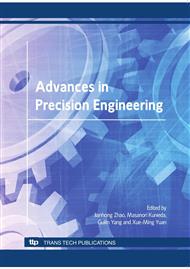p.71
p.76
p.81
p.86
p.91
p.96
p.101
p.106
p.111
Forming of Microstructure on Hard Brittle Materials in Ductile Mode Cutting
Abstract:
The requirement of the ultra-precision machine tools for ductile cutting of hard brittle materials was examined experimentally. One of the essential factors of achieving ductile mode cutting was not only high-resolution feedback control but also the dynamic performance of the machine tool in forming solid immersion lens of monocrystalline silicon. We also proposed newly developed method for ultra-precision machine tools, which does not have enough high dynamic performance in order to achieve ductile mode cutting of the hard brittle materials. An additional device consisted of air slider on the machine tool was applied to cutting of glass in order to keep stable ductile mode cutting. We fabricated high-value added structure, which are designed a diffraction grating, consisted of micro groove on a borosilicate crown glass surface with the developed device.
Info:
Periodical:
Pages:
91-95
Citation:
Online since:
September 2010
Price:
Сopyright:
© 2010 Trans Tech Publications Ltd. All Rights Reserved
Share:
Citation:


